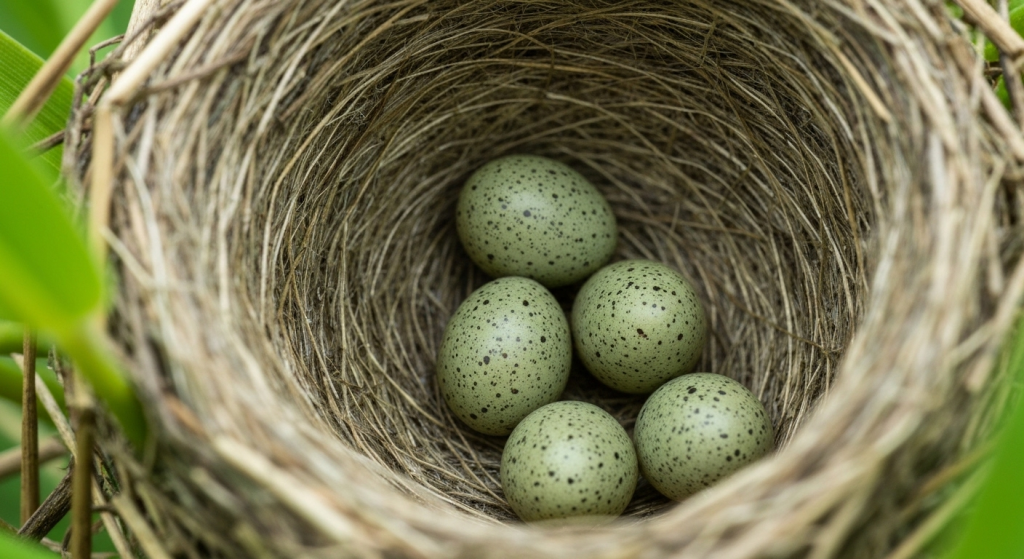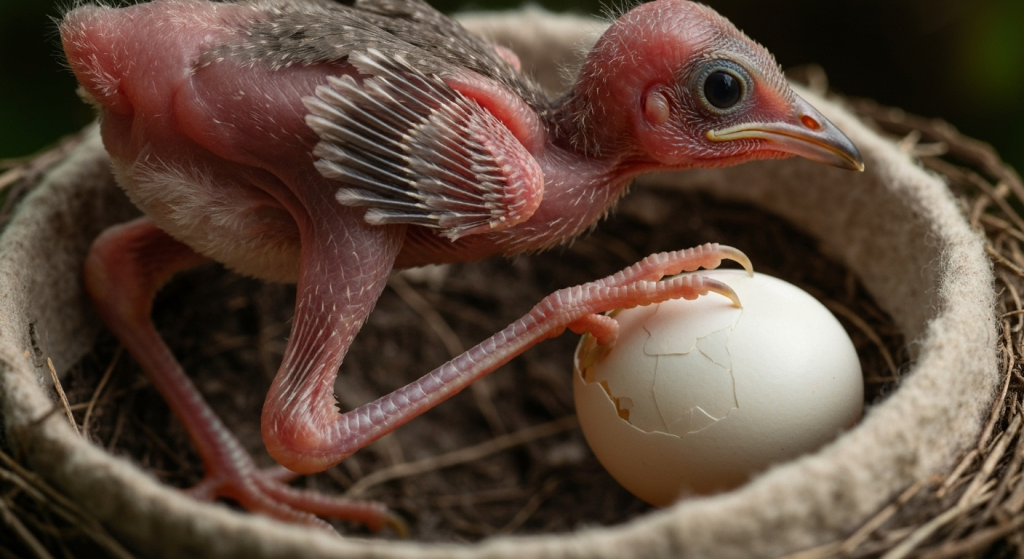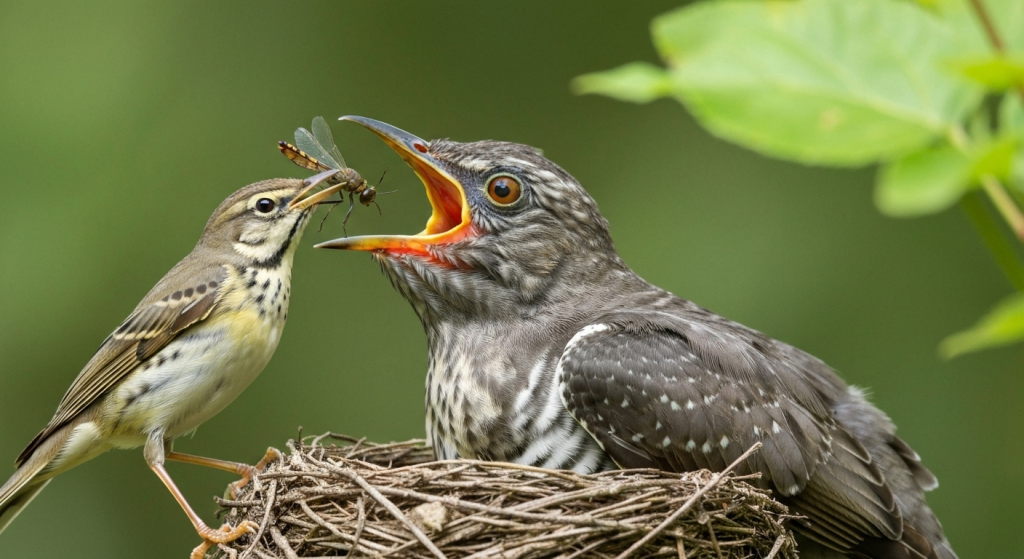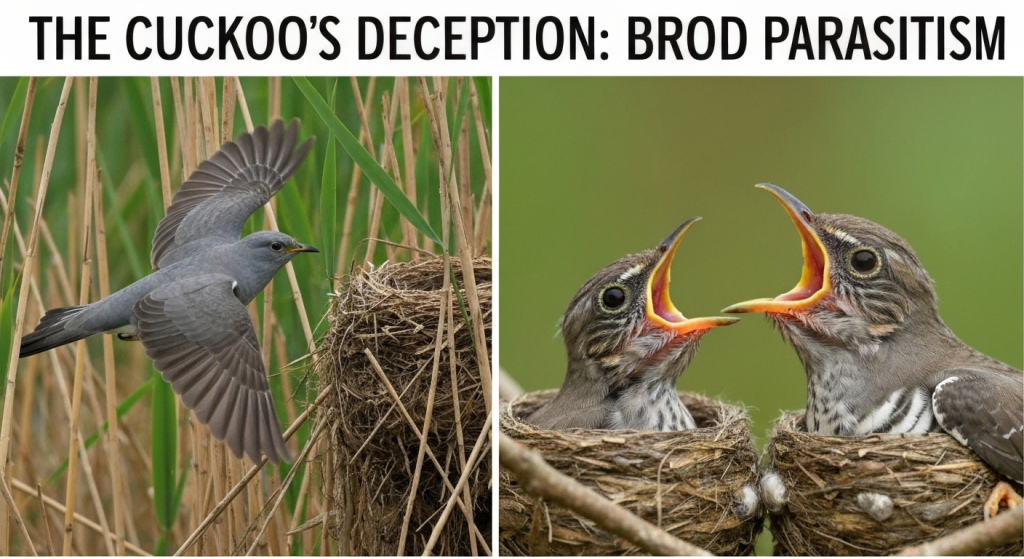Have you ever been walking through the woods and heard that distinctive cuck-oo call echoing through the trees? It’s a sound that many of us associate with clocks or the arrival of spring. But behind that simple two-note call lies one of nature’s most fascinating and ruthless survival strategies. The cuckoo is a master of deception, a bird that has outsourced the entire job of parenting to unsuspecting strangers. They don’t build nests, incubate eggs, or feed their young. Instead, they trick other birds into raising their offspring for them.
This strategy, known as brood parasitism, isn’t just a quirky habit; it’s a highly evolved, complex game of espionage and trickery. It’s a biological arms race where the cuckoo must constantly refine its methods of deception, while the host species must learn to spot the imposter. For bird watchers and nature lovers, understanding the cuckoo’s lifestyle is like uncovering a secret plot happening right in our backyards. It raises so many questions: How do they get away with it? Why do the host birds fall for it? And what evolutionary advantage could possibly come from abandoning your own young? Let’s break down the incredible science behind the cuckoo’s deceptive genius.
My name is Mahnoor Farooq, and for the better part of a decade, I’ve been captivated by the intricate lives of birds. My work has taken me from dense woodlands to quiet riverbanks, always with binoculars in hand, trying to decipher the “why” behind their behaviors. This passion for avian strategies has led me to write about everything from migration patterns to complex social structures. My goal is simple: to share the wonder of the bird world, breaking down complex science into stories that everyone can appreciate and understand. The cuckoo’s strategy, in particular, is a subject I’ve returned to time and again, as it perfectly showcases the powerful and sometimes brutal pressures of evolution.
What Is Brood Parasitism? The Cuckoo’s Survival Blueprint
At its core, brood parasitism is a reproductive strategy where one animal, the parasite, lays its eggs in the nest of another animal, the host, who then raises the young as its own. The host is left to invest all its time and energy—from incubation to feeding—into an offspring that is not its own, often at the expense of its actual young. While other species like cowbirds and honeyguides also practice this, the Common Cuckoo (Cuculus canorus) is the most famous and well-studied example.
This isn’t just laziness; it’s a highly effective way to maximize reproductive output without paying the high cost of parenting. Building a nest, incubating eggs for weeks, and constantly foraging for hungry chicks is an enormous drain on a bird’s energy reserves and exposes it to predators. By skipping all of this, a female cuckoo can lay far more eggs in a single season—sometimes over 20 in different nests—than a typical songbird that has to manage its own nest.
From an evolutionary perspective, the goal is to pass on your genes as successfully as possible. The cuckoo has simply found a shortcut. This strategy, however, only works if the cuckoo can successfully trick the host. This has led to an incredible series of adaptations designed to fool even the most attentive parents.
The Art of the Con: How Cuckoos Perfect Their Deception
A cuckoo can’t just drop an egg in any random nest and hope for the best. The entire process is a masterclass in stealth, mimicry, and timing. Generations of evolution have turned the female cuckoo into a highly specialized secret agent.
Mastering the Disguise: The Evolution of Egg Mimicry

The cuckoo’s single greatest weapon is egg mimicry. If a host bird returns to its nest and finds an egg that looks wildly different from its own, it will likely recognize it as foreign and either push it out of the nest, abandon the nest entirely, or build a new one on top of the old clutch. To avoid this, cuckoos have evolved to lay eggs that are remarkably similar in color, size, and pattern to the eggs of their chosen host species.
This isn’t a one-size-fits-all adaptation. The cuckoo species is actually divided into different genetic lineages, or gentes, each specializing in a specific host species. One cuckoo gens might exclusively target Reed Warblers and lay small, speckled, olive-green eggs. Another might target Robins and lay blue eggs. This specialization is passed down on the female side of the family. A female cuckoo will seek out the nest of the same species that raised her.
Here’s a look at how precise this mimicry can be:
| Host Species | Host Egg Appearance | Cuckoo Egg Appearance |
| Reed Warbler | Small, pale green with olive spots. | Nearly identical size, base color, and spotting pattern. |
| Dunnock | Small, bright, unmarked blue. | Larger, but a similar shade of blue to fool the less discerning Dunnock. |
| Pied Wagtail | White with fine grey and brown speckles. | Matches the base color and speckling almost perfectly. |
| Meadow Pipit | Brownish with dense, dark mottling. | A close match in mottling, making it hard to spot in a dark nest. |
In my fieldwork, seeing these clutches firsthand is always stunning. The first time I examined a parasitized Reed Warbler nest, it took me a few moments to even identify the cuckoo egg. It was only slightly larger, but the coloration was so perfect that it drove home just how intense the evolutionary pressure is on the cuckoo to get it right.
Timing is Everything: The Cuckoo’s Blitz Attack
A female cuckoo spends much of her time watching and waiting. She quietly observes her target hosts as they build their nest and begin to lay their own eggs. She needs to strike at the perfect moment. If she lays her egg too early, the host may notice and abandon the nest. If she lays it too late, her chick won’t hatch in time to get a head start on its nestmates.
The ideal window is during the host’s egg-laying period. When the host female leaves the nest to forage, the cuckoo makes her move. The process is incredibly fast, often lasting no more than 10 seconds.
- She swoops down to the nest.
- She removes one of the host’s eggs to avoid suspicion.
- She lays her own egg directly in its place.
- She flies off with the host’s egg, which she typically eats later.
This speed is a crucial adaptation to avoid being caught by the returning parents, who would mob her and drive her away.
Choosing the Right Target: Host Selection Strategy
Not all bird species make good foster parents. Cuckoos have evolved to select hosts with specific characteristics that increase the chances of their chick’s survival.
- Diet: The host must be an insectivore (insect-eater). A cuckoo chick is large and needs a high-protein diet of insects to grow quickly. A finch that feeds its young seeds would be a poor choice, as the cuckoo chick would starve.
- Nest Shape and Size: The nest needs to be strong enough to hold a rapidly growing cuckoo chick, which will eventually dwarf its foster parents. Cup-shaped nests are ideal.
- Parental Behavior: The best hosts are diligent and attentive parents who spend a lot of time foraging for their young. Species like Reed Warblers and Meadow Pipits are prime targets because they are tireless providers.
- Vigilance Level: While cuckoos need attentive parents, they also benefit from hosts that are not too good at spotting foreign eggs. For example, Dunnocks are known to be less discriminating and will often accept eggs that are a poor match, making them a common target.
A Hostile Takeover: Life Inside the Foster Nest
Once the cuckoo egg has been successfully laid, the deception enters its next phase. The host parents, unaware of the swap, return and begin incubating the clutch, cuckoo egg and all.
The Eviction: A Cuckoo Chick’s First Brutal Act

The cuckoo’s adaptations continue even after hatching. The cuckoo egg has a shorter incubation period than the host’s eggs, meaning it hatches first. This gives the cuckoo chick a critical head start. Within hours of hatching, a blind, naked, and seemingly helpless cuckoo chick is driven by a powerful instinct to eliminate all competition.
It will maneuver itself underneath the other eggs or newly hatched chicks in the nest. A small, sensitive hollow on its back triggers a pushing response when it makes contact with another object. It will then use its surprisingly strong legs and back to hoist the egg or chick up the side of the nest and push it over the edge. It repeats this process until it is the sole occupant of the nest. This behavior is instinctual and ensures that it will receive 100% of the food brought back by its foster parents. It’s a brutal but effective strategy for survival.
The Super Stimulus: Duping the Foster Parents

Now alone in the nest, the cuckoo chick has another challenge: convincing its tiny parents to feed it enough food. A single cuckoo chick can grow to be three or four times the size of its foster parents. To get the amount of food it needs, it has to trick them into thinking they are feeding a full brood of their own chicks.
It does this by becoming a “supernormal stimulus.”
- Intense Gape: Its beak lining is a bright, vibrant red, and its gape (the opening of its mouth) is enormous. This visual cue acts as an irresistible trigger for the parents’ feeding instinct.
- Rapid, Loud Begging Calls: The chick’s begging calls are fast and insistent, mimicking the sound of an entire brood of hungry chicks. Research has shown that the cuckoo’s begging call rate is similar to that of four Reed Warbler chicks combined.
The foster parents become slaves to these exaggerated signals. They work tirelessly to stuff insects into this giant, demanding mouth, completely unaware that they are raising a monster who murdered their own offspring. From my own observations, watching a tiny Reed Warbler desperately trying to feed a fledgling cuckoo that is several times its size is one of the most surreal and memorable sights in the bird world.
An Evolutionary Arms Race: Hosts Fight Back
The host species are not passive victims in this drama. Over millennia, they have developed their own set of counter-adaptations to fight back against the cuckoos. This has created what biologists call a coevolutionary arms race, where each side continuously evolves new strategies in response to the other.
Nest Defense and Mobbing
The first line of defense is to prevent the cuckoo from laying an egg in the first place. Many birds can recognize adult cuckoos as a threat. When a cuckoo is spotted near a nest, smaller birds will often “mob” it—they will band together, dive-bomb the cuckoo, and make loud alarm calls to drive it away. This collective defense can be very effective at protecting a colony of nests.
Learning to Spot the Fake: Egg Rejection
The best defense for many hosts is learning to identify the parasitic egg. This is where individual recognition comes in.
- Signature Patterns: Some species have evolved to lay eggs with highly variable and unique patterns, almost like a signature. This makes it much harder for a cuckoo to produce a convincing forgery. If the host sees an egg that doesn’t match its own “signature” pattern, it’s more likely to reject it.
- Rejection Behavior: Once an egg is identified as foreign, the host might push it out of the nest, pierce it with its beak, or simply abandon the entire clutch and start over.
This ongoing battle has led to a fascinating back-and-forth, as shown in the table below.
| Host Tactic | Cuckoo Counter-Tactic |
| Birds develop better egg recognition. | Cuckoos evolve more precise egg mimicry. |
| Hosts lay eggs with unique “signatures.” | Cuckoos lay a wider variety of egg patterns to increase the chance of a match. |
| Birds mob and attack adult cuckoos. | Cuckoos evolve hawk-like markings to intimidate small birds and lay their eggs faster. |
| Hosts abandon parasitized nests. | Cuckoos monitor the nest and will destroy the clutch if their egg is rejected, forcing the host to re-nest. |
This arms race is a perfect example of natural selection in action. Only the best cuckoo deceivers succeed, and only the best host detectives manage to raise their own young. This constant pressure drives the evolution of both species.
Frequently Asked Questions (FAQs)
Do all species of cuckoo practice brood parasitism?
No, not all of them. Out of about 140 cuckoo species worldwide, only around 60 are obligate brood parasites (meaning it’s their only method of reproduction). Other cuckoos, like the Yellow-billed and Black-billed Cuckoos in North America, typically build their own nests and raise their own young.
Do the foster parents ever realize the chick isn’t theirs?
It seems that once the chick has hatched, the parental instinct to feed a begging mouth is so strong that it overrides any ability to recognize the chick as an imposter. Even when the cuckoo chick is monstrously large compared to them, they continue to feed it. The “supernormal stimulus” of the gape and calls is just too powerful to ignore.
What happens to the cuckoo chick after it leaves the nest?
The foster parents continue to feed the cuckoo fledgling for a few weeks after it leaves the nest (fledges). After that, the young cuckoo is on its own. It will soon migrate to its wintering grounds in Africa, guided entirely by instinct, and will return the next spring to repeat the parasitic cycle. It never meets its biological parents.
Is brood parasitism “bad” for the host species?
While it is devastating for the individual host parents who lose their entire brood, it doesn’t usually threaten the entire host population. Cuckoos only parasitize a fraction of the available nests. The host populations have remained stable over time, partly because the “arms race” ensures that many of them successfully fend off the cuckoos. It’s a natural, albeit brutal, part of the ecosystem’s balance.
Conclusion: A Strategy of Brutal Elegance
The cuckoo’s reproductive strategy is a powerful reminder that evolution is not driven by morality or fairness, but by what works. Brood parasitism is a high-risk, high-reward approach to survival that has been refined over millions of years. Through incredible adaptations like egg mimicry, rapid egg-laying, and the manipulation of host behavior, the cuckoo has become one of nature’s most successful con artists.
At the same time, the fight put up by the host species—from mobbing predators to developing intricate egg signatures—shows that no strategy goes unchallenged in the natural world. This coevolutionary arms race is a dynamic and ongoing battle of wits that plays out every spring in woodlands and reed beds around the world. So the next time you hear that familiar cuck-oo call, you’ll know you’re hearing the sound of a true master of deception, a testament to the brutal elegance of evolution.


